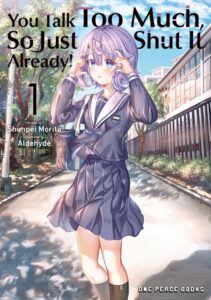Although numerous manga stories revolving around disabled characters exist, such stories make up only a small minority of the total number of published manga. So manga about disabled characters seem somewhat rare. Moreover, manga about disabled characters typically fall into two categories: emotionally hammering stories and stories which treat a disability as a personality characteristic. The playful and amusing manga series You Talk Too Much, So Just Shut It Already! (Kimi wa Yakamashi Tojite yo Kuchi o) falls squarely into the later category. One Peace Books has recently released an official English language translation of the first of four volumes of Shunpei Morita & Aldehyde’s lighthearted dramedy manga ideal for slice-of-life readers seeking a little twist on the ordinary.
You Talk Too Much, So Just Shut It Already! stars Tsukino Hiiragi, a deaf girl who transfers into a new school. She’s seated next to outgoing boy Taiyo Enomoto who insists on constantly speaking to her even though she can’t hear his voice. In fact, even for a deaf girl, Taiyo’s persistent yammering feels a bit confusing and annoying. Tsukino is further put off-balance by the very fact that Taiyo treats her exactly as he does everyone else, regardless of her disability. Much humor arises from Taiyo’s simplistic and kindhearted belief that passion and desire alone will allow him to comprehend Tsukino’s Japanese sign language. Roughly half-way through the first book, the story elevates classmate Sakura as a third major character. The sly and mischievous girl Sakura serves as a sort of tsukkomi opposite to Taiyo’s role as a laughable boke fool.
The manga script by Shunpei Morita concentrates on cheerful comedy including sitcom misunderstandings and bizarre personality quirks, more from Taiyo and Sakura than from disabled protagonist Tsukino. However, the first volume does occasionally drop hints of Tsukino having lived a traumatic past, suggesting that the future volumes may include a more serious examination of the complications arisen from Tsukino’s condition in her past. Illustrator Aldehyde’s graphic art is consistently refined, detailed, and attractive with one noticeable exception. Character rendering is manga-esque but very precise. Aldehyde is obviously a master of using few lines to express dynamic expression and emotion.
But whether due to the author’s original description or the illustrator’s interpretation, Aldehyde routinely depicts Taiyo Enomoto with such a long face that the young boy frequently looks nearly dipropionate. He often seems to have too much vertical distance between his eyes and his mouth, making his head seem egg-shaped instead of round. Most of the first manga volume is set indoors, which limits the need for extensive background art. On the few occasions that the story does venture outdoors, Aldehyde’s art is just as consistently strong, depicting outdoor scenery backgrounds in vivid detail. Both creators appear to be at least moderately familiar with formal sign language because the story periodically takes pains to accurately depict Japanese signing, typically as a means to make a joke over a linguistic misunderstanding.
The official English translation by Jordan Taylor exhibits no errors in grammar but is slightly uneven. Whether due to the translator’s efforts or the nature of the original Japanese script, the first few chapters of the book give the two primary characters slight verbal quirks. A slightly stilted British tone permeates the translation early on through phrases including, “What is he on about?” “I don’t know what he’s on about, but oh my goodness does he talk,” and, “I will not fold to your taunts.” But the script becomes more fluid and uniform in the second half of the volume. In parallel, while Japanese sound effects are retained throughout and translated in-panel, Japanese text in-panel is translated into English until about half-way through the volume when it begins being left in native Japanese. One Peace Books’ presentation contains the story’s first ten chapters, a short bonus chapter, and afterword messages from the creators. The manga’s original one-shot chapter is not included. The story is all-ages friendly, containing nothing offensive in script, story, or illustration.
Manga revolving around disabled people, including Yoshitoki Oima’s Koe no Katachi (A Silent Voice) and Keiko Tobe’s Hikari to Tomo ni… (With the Light) tend to be pathos-fueled emotional wringers. On the opposite side of the scale, manga including Sousuke Toka’s Ousama Ranking (Ranking of Kings) and Morishita Suu’s Yubisaki no Renren (A Sign of Affection) star disabled characters but don’t get heavily absorbed into the pathos of their character’s conditions. Shunpei Morita & Aldehyde’s manga You Talk Too Much, So Just Shut It Already! is one of the later style of manga. While the protagonist has a physical disability, it’s mostly treated like a personality trait such as being short, introverted, or brainy. The first book uses Tsukino’s deafness as a source of humor without making Tsukino herself a victim or the butt of jokes. In fact, most of the manga’s humor comes from Taiyo’s tendency to entirely ignore Tsukino’s disability. At least the first manga volume is innocuous, enjoyable but ordinary despite its distinctive protagonist. Readers who are curious about You Talk Too Much, So Just Shut It Already! absolutely should try out the series. Potential readers who approach the story completely blind can do so without any reason for trepidation. You Talk Too Much, So Just Shut It Already! is a pleasant, lightweight sitcom manga that stars a deaf girl but doesn’t get weighed down in angst and pathos over its protagonist’s disability.




